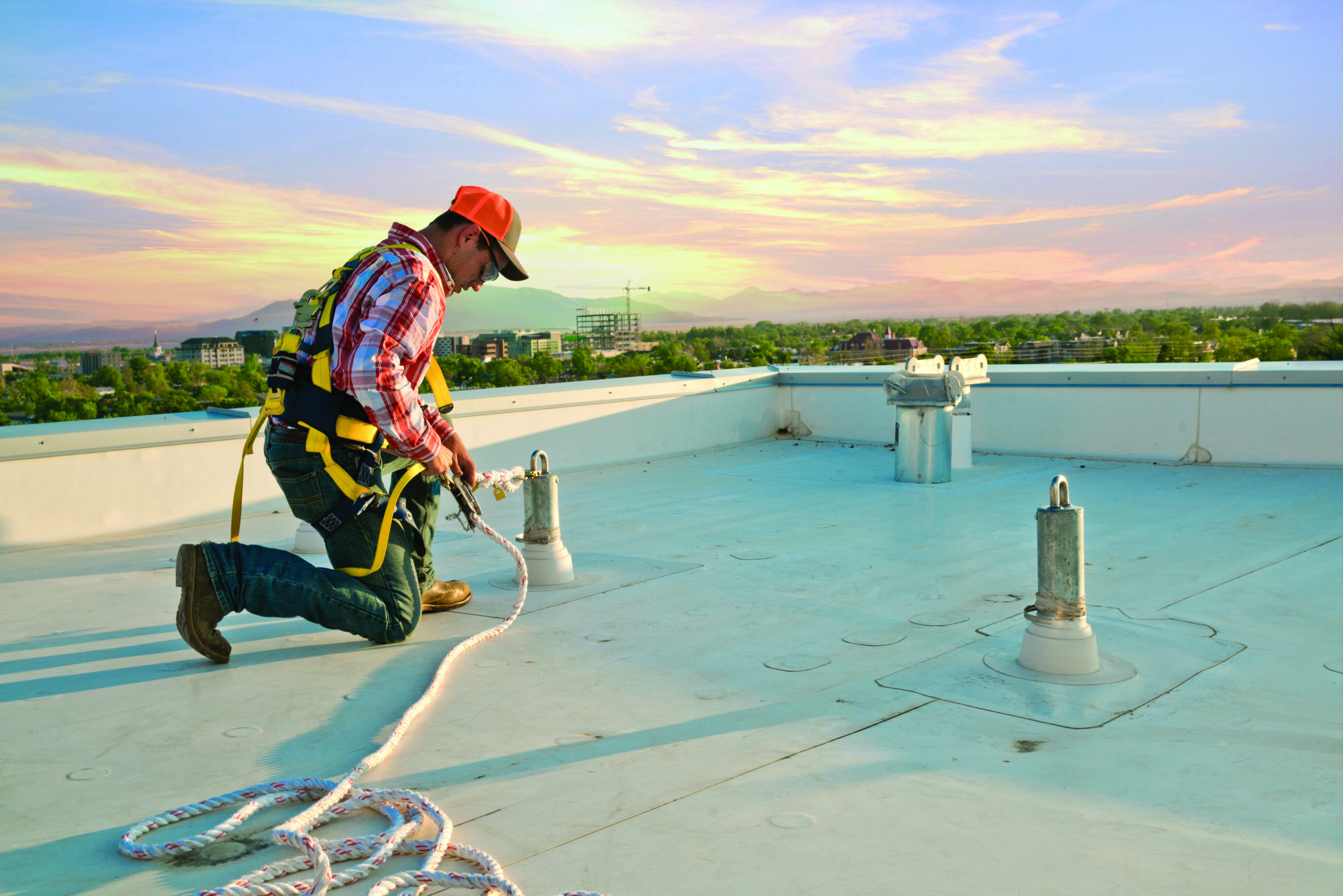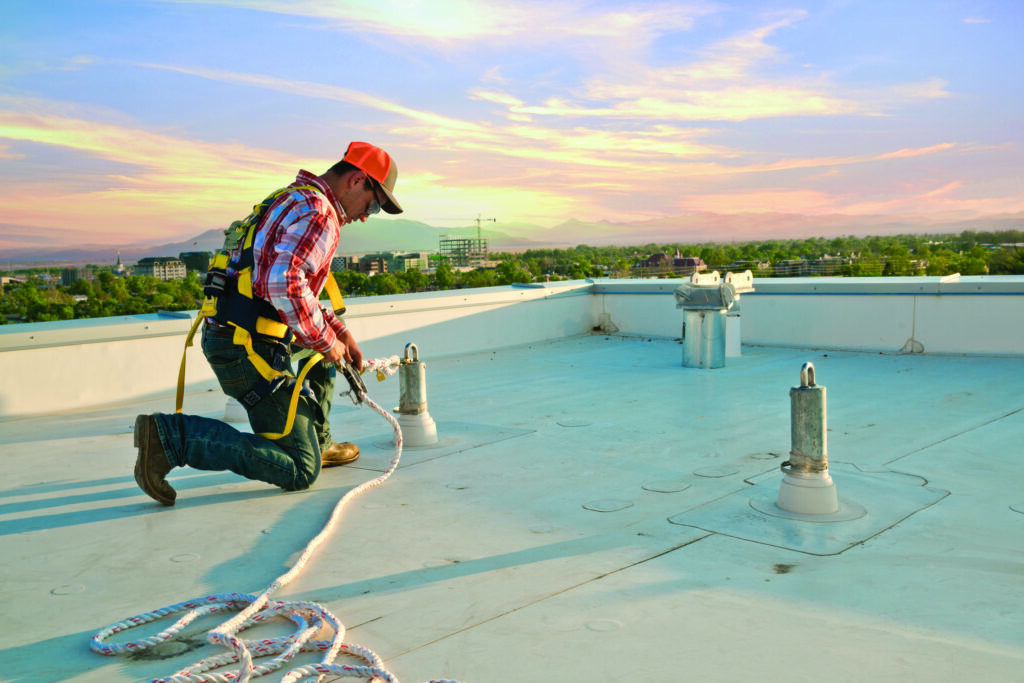Falls from heights account for hundreds of workplace fatalities every year. Having a fall protection competent person responsible for overseeing an organization’s fall protection strategy is critical.

Fall protection insights
- Falls from heights account for 600 to 800 workplace fatalities annually.
- Pre-use inspections are required by OSHA for all fall protection equipment before each use.
- A competent person is responsible for building the fall protection program and drafting safe work procedures.
Robust fall protection plans can be a pillar in many organization’s safety programs. Slips, trips and falls are a leading cause of workplace injuries and fatalities, according to the U.S. Bureau of Labor Statistics (BLS). Falls from heights are responsible for 600 to 800 workplace fatalities annually. In almost every industry, workers will be exposed to heights and could be injured from falling.
The success of a fall-protection program can be significantly affected by its designated competent person. For a competent person to run an effective fall protection program, they must not only carry the designation of title but also be competent in their fall protection knowledge and apply it to prevent injuries. A fall-protection competent person’s efforts can benefit an organization in many ways other than keeping workers safe.
What is a competent person?
The Occupational Safety and Health Administration (OSHA) 1910 (General Industry), OSHA 1926 (Construction) and the American National Standards Institute Z359 standards all require organizations to designate at least one employee as a competent person for their fall protection program. The federal OSHA General Industry 1910.140 standard defines a competent person as:
“A person who is capable of identifying existing and predictable hazards in any personal fall protection system or any component of it, as well as in their application and uses with related equipment, and who has the authorization to take prompt, corrective action to eliminate the identified hazards.”
In simple terms, the competent person is the facilitator of the fall protection program. Additionally, more than one competent person is permitted and even encouraged by industry consensus. The competent person must approve any substitutions or changes made to the program. They are also responsible for annual inspection of the fall protection equipment, periodically conducting fall hazard assessments of the facility, designating and training authorized users and maintaining records and documentation for the program.
Fall protection equipment inspection requirements
OSHA requires all fall protection equipment to be inspected by the user before each use, referred to as the pre-use inspection. This inspection is performed to verify product labels are still intact, the equipment has not already arrested a fall and check for physical defects or issues that could cause failure during use. If the equipment fails inspection, users must report the equipment to their competent person to replace it before they begin work at heights.
OSHA also requires an annual inspection of all fall protection equipment to be performed by the organization’s competent person or a third-party ANSI-accredited fall protection equipment inspector. The annual inspection checks for all the same criteria as the pre-use inspection but is documented, so consistent records are kept for all fall protection equipment currently used by the organization. In the event of a fall incident, inspection records will likely need to be reviewed. The annual inspection must also document the equipment type (anchor, harness, lanyard, etc.), manufacturer, model number, date of manufacture, indication of pass/fail, date of inspection and the inspector’s name.
It should be noted that annual equipment inspections do not have to be conducted all at once, but every piece of equipment must be inspected by the competent person at least once every 12 months. Employers should know what federal or state OSHA program is relevant to their organization and if their requirements differentiate from federal OSHA. For example, In California, Cal/OSHA requires construction companies to perform this documented inspection once every six months for each piece of equipment.

Conducting fall hazard assessments
Since the competent person is responsible for building the fall protection program and drafting safe work procedures, they must be able to survey the organization’s facility, identify where fall protection is required and implement solutions to prevent injury.
The first step in that process is conducting a fall hazard assessment to identify all existing fall hazards inside, outside or on top of the facility — wherever employees will perform their duties. If a company is subject to federal OSHA 1910 requirements, fall protection will be required anywhere an employee is exposed to a fall of 4 feet or greater. Additionally, the competent person may conduct fall hazard assessments with a fall protection provider present to help configure proposals to mitigate any found fall hazards.
While conducting site surveys, evaluating the effectiveness of current fall protection equipment and solutions is also important. The goal of a fall hazard assessment should be to provide workers with practical solutions that are simple to use or incorporate into standard work procedures.
Eliminating the hazard by changing how the job is done is the most effective way to prevent injury because it prevents the fall from occurring altogether. For example, purchasing drop-down ceiling lights that can be serviced from the ground instead of the worker climbing a ladder would eliminate the hazard.
If changing how or where the work must be performed, the next most effective method would be to install physical barricades, like guardrails. Guardrails are considered passive safety systems because they require no user input to be effective. The worker must simply stay behind the guardrail to prevent falling.
The last option would be to provide the worker with personal protective equipment (PPE) and a fall arrest system that can mitigate the severity of their fall injury — as fall arrest systems cannot prevent falls from occurring. However, providing fall arrest systems is one matter and workers using those systems correctly is another.
Fall protection training requirements
According to a 2021 study from the Center for Construction Research and Training (CPWR), an alarming 60% of fatal falls occurred while the worker was using some form of fall protection. This data reinforces the notion that fall protection is only effective if workers are trained to use the equipment properly and follow safe work practices. The success of a fall protection program is contingent on thorough training and effective enforcement by safety leadership.
The competent person is responsible for determining who at the organization will need to use fall protection equipment, designating those workers as authorized users and providing initial training on OSHA requirements and ANSI guidelines. Organizations can have third-party trainers like Diversified Fall Protection or other manufacturers to provide authorized user training. And while OSHA is clear about the need for user designation and providing initial training, its requirements for retraining are vaguer. OSHA requires retraining when equipment, environments or policies change –– or when an employee displays a gap in understanding of fall protection knowledge that could put themselves or others in danger. Most industry experts recommend annual fall protection training, at a minimum, to refresh workers’ knowledge and provide an opportunity to hear feedback from frontline employees for possible program improvements.
OSHA is clear, however, on retraining requirements for the competent person. This certification must be refreshed every two years. Additionally, if company work is ever under EM385 jurisdiction of the U.S. Army Corps of Engineers, the competent person requirement is more strict than federal OSHA. EM385 standards require a competent person to have authorized rescue training as well, requiring an additional eight hours of training on initial certification and refresher courses.
Organizational benefits of a successful fall protection program
A fall protection program’s effectiveness can benefit the organization in many ways, other than simply protecting workers from falls. Fall incidents resulting in injury or fatality can be costly for employers and will impact the business in several ways. The National Safety Council (NSC) reports that the average non-fatal fall incident costs approximately $50,000 in workers’ compensation costs alone. The organization will likely be subject to other direct costs related to the fall, like OSHA fines and litigation fees. Those direct costs are more difficult to estimate because they can vary in amount depending on the severity of the fall incident.
Falls in the workplace have also been shown to diminish morale, reduce workforce productivity and increase employee turnover. The employer can potentially lose business when bidding on work due to a tarnished reputation and find it difficult to regain the trust of current employees. Some sources estimate that these indirect costs related to a fall incident can add up to four times as much as direct costs. On top of that, nobody wants to have the injury or death of an employee on their conscience.
Falls are preventable
Maintaining a comprehensive fall protection program is extensive work that must be meticulously managed if the organization wants to keep workers safe. Falls continue to be a leading cause of injury and fatality in the workplace, but they are also preventable. With proactive planning, practical solutions and cooperation at all levels of the business, every fall protection program has the potential to be successful and protect workers.
An organization’s competent person carries the weight of many responsibilities, but it is important to remember they are not alone in this endeavor. Many resources are available to assist a competent person with equipment inspection, hazard assessment, personnel training and regulatory updates. A truly strong and capable competent person will not believe they can do it all on their own, but they will know when to ask for support and use every resource at their disposal to avoid injuries and keep people safe. The work we perform today to protect workers from falls has the potential to save lives tomorrow.